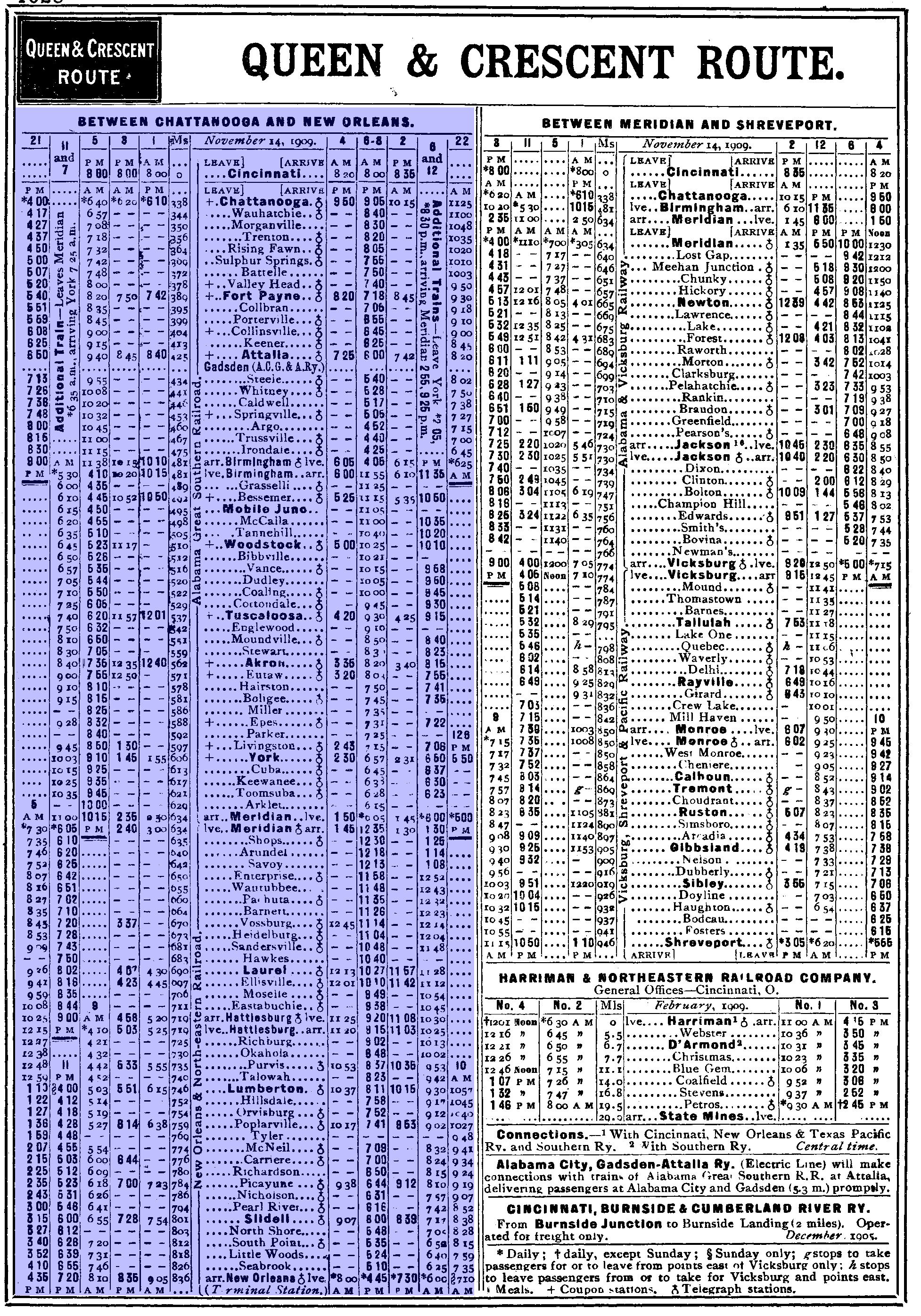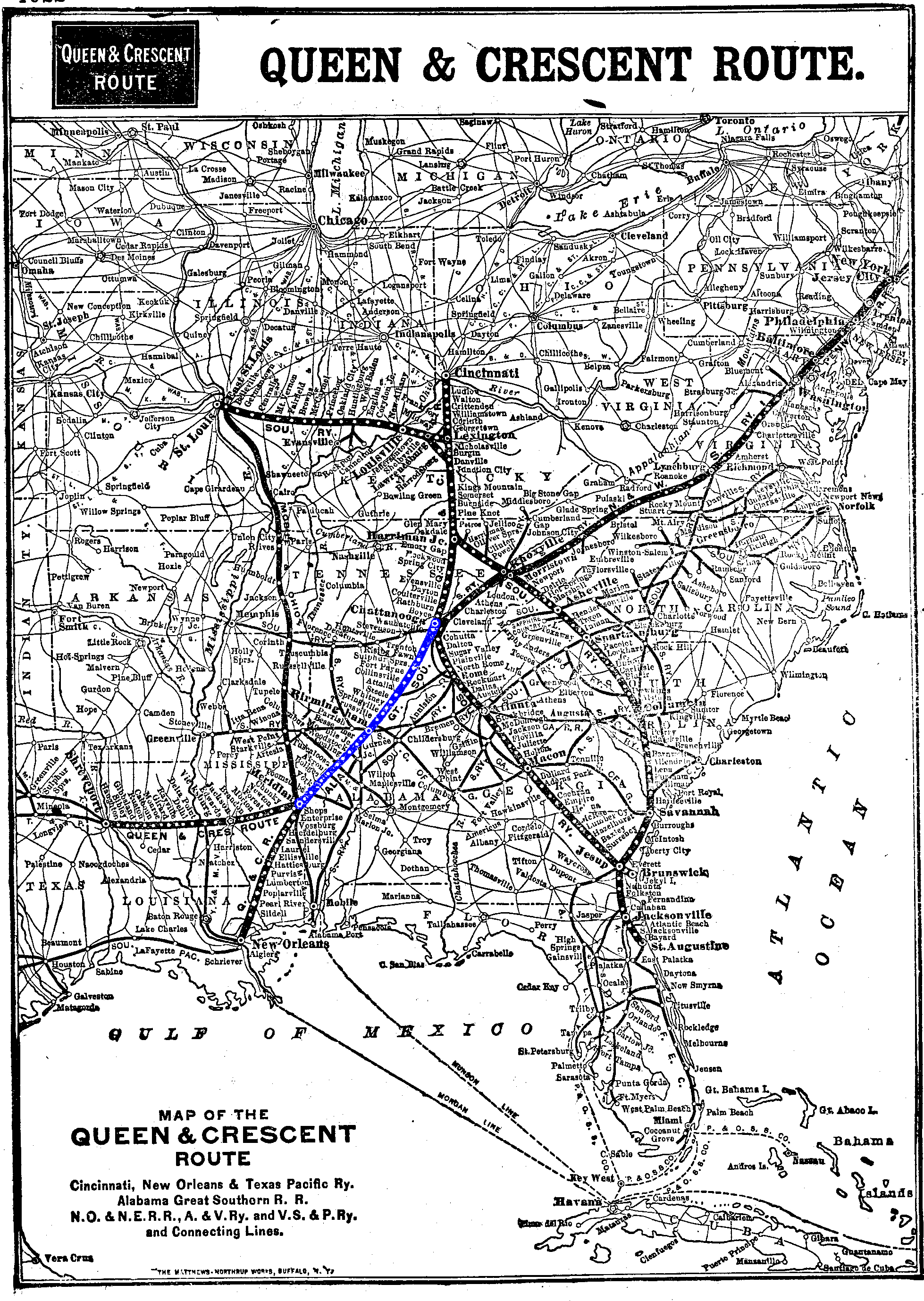Alabama Great Southern Railroad: Map, History, Timetables
Published: February 16, 2025
By: Adam Burns
The Alabama Great Southern Railroad (AGS) played a pivotal role in the economic and industrial development of the southern United States.
The system - linking Chattanooga, Tennessee with Meridian, Mississippi - would eventually become part of the Queen & Crescent Route, a marketing term used by the Alabama Great Southern; Cincinnati, New Orleans & Texas Pacific; and New Orleans & Northeastern that provided a through route between Cincinnati and New Olreans. All three operated as subsidaries of the Southern Railway.
The AGS maintained 296 route miles between Meridian-Chattanooga and 498 route miles to New Orleans. Today, it continues to function as a subsidiary of Norfolk Southern (NS). Additionally, AGS holds an approximate 30% stake in the Meridian-Shreveport Meridian Speedway, utilized by Canadian Pacific Kansas City.
System Map (1910)
Origins and Formation
The origins of the Alabama Great Southern Railroad can be traced back to the need for efficient transportation routes following the Civil War. The Southern states were eager to rebuild their economies, and railroads were seen as the key to linking regional agricultural and industrial markets with national and international trade networks.
The AGS was initially a component of larger, ambitious plans designed by entrepreneurs and financiers. The earliest predecessor was the Wills Valley Railroad (WVRR), which received its charter from the Alabama Legislature in February 1852. The charter permitted its construction from a junction on the Alabama & Tennessee River Railroad northeastward to the Georgia border.
Subsequently, in early 1854, the legislatures of Georgia and Tennessee granted authorization for the railroad to continue its extension to a connection with the Nashville & Chattanooga Railroad. Meanwhile, another enterprise, the North East & South West Alabama Railroad, was chartered in Alabama in December 1853 and in Mississippi in February 1854.
This line was to extend from Meridian, through several Alabama towards Knoxville, Tennessee. In June 1856, the federal government enacted legislation conferring land grants to both companies, which Alabama allocated in January 1858: from Mississippi to near Gadsden for the North East & South West, and from near Gadsden to Georgia for the WVRR.
Both railroads commenced construction from their respective endpoints outside Alabama. By December 1860, the WVRR had completed its line from the Nashville and Chattanooga Railroad at Wauhatchie, Tennessee to Trenton, Georgia, with rights to operate over the Nashville & Chattanooga into Chattanooga.
Concurrently, the North East & South West initiated its construction at Meridian, reaching an intersection with the Alabama & Mississippi Rivers Railroad at York, Alabama, and it was subsequently leased to the latter.
Expansion and Development
In the aftermath of the Civil War, a consortium of Boston financiers led by John C. Stanton gained control of the two railroads. The legislature sanctioned their merger in November 1868, forming the Alabama and Chattanooga Railroad.
As a result, Georgia, Tennessee, and Mississippi renamed their respective sections in March 1869, February 1870, and May 1871. By May 1871, the line was fully operational.
It remained under various operations, including the connecting New Orleans & Northeastern Railroad, until its reorganization in November 1877 into the Alabama Great Southern Railroad.
After spending the 1880s under a British-controlled paper company, the AGS was acquired by the Richmond and Danville Railroad in 1890, forerunner to the modern Southern Railway system created by none other than J.P. Morgan on July 1, 1894.
Timetable (1910)

Impact on Alabama and the Region
The establishment and expansion of the Alabama Great Southern Railroad had profound effects on Birmingham, Alabama, and neighboring regions. Birmingham, known as the "Magic City," witnessed rapid growth into a major industrial center thanks in part to the rail network. The AGS facilitated the shipping of raw materials needed for steel production, contributing to Birmingham's emergence as a steel powerhouse.
The railroad also promoted agricultural development by providing farmers with reliable access to national markets, thus transforming the agricultural economy. Cotton, a dominant cash crop, became even more profitable for Alabama farmers as they could now reach broader markets efficiently.
Moreover, the AGS contributed to the urbanization of the South by enabling the movement of people. This migration facilitated a cultural and demographic shift in many regions that would have lasting social implications for decades.
The 20th Century and Beyond
Throughout the early to mid-20th century, the AGS continued to operate as part of the larger Southern, maintaining its critical role in freight and passenger services to New Orleans.
The development of the interstate highway system and the rise of the trucking industry in the post-World War II era led to a decline in passenger rail service throughout the country. Despite these changes, the AGS remained integral in freight service, adapting to the new economic conditions by continuing to transport bulk commodities.
The Southern underwent further consolidation in the 1980s, merging with Norfolk & Western to form the Norfolk Southern in 1982.
Legacy and Modern Influence
The legacy of the Alabama Great Southern Railroad is still visible today. In addition to shaping Alabama's economic and industrial development, it played a significant role in fostering interconnectedness and mobility in the southern United States.
The AGS main line continues to remain an important component under Norfolk Southern, continuing to serve as critical freight corridor.
In closing, the AGS was more than just a transportation venture; it was a catalyst for transformation in the American South. Its story reflects the broader narrative of American industrialization, regional development, and technological progress. Through its contributions to the economic and social fabric of the South, the AGS stands as a testament to the enduring power of railroads in shaping history.
Recent Articles
-
North Carolina Christmas Train Rides On The Tweetsie!
Dec 07, 25 10:02 AM
Each year, the Tweetsie Railroad's signature holiday attraction—Tweetsie Christmas—transforms the property into one of the region’s most enchanting winter experiences. -
New Hampshire Christmas Train Rides In Conway!
Dec 07, 25 09:50 AM
Conway Scenic Railroad's Santa’s Holiday Express transforms a classic train ride into a timeless tradition. -
New Jersey Christmas Train Rides In Woodstown!
Dec 07, 25 09:44 AM
Tucked into the farm country of Salem County, New Jersey, the Woodstown Central Railroad has quickly become one of the region’s most talked-about excursion lines, including Christmas specials!




